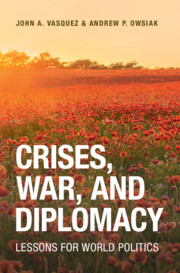Refine search
Actions for selected content:
50 results
The Unconstrained Future of World Order: The Assault on Democratic Constraint and Implications for US Global Leadership
-
- Journal:
- International Organization / Volume 79 / Issue S1 / December 2025
- Published online by Cambridge University Press:
- 20 November 2025, pp. S71-S87
- Print publication:
- December 2025
-
- Article
-
- You have access
- Open access
- HTML
- Export citation
17 - General Lessons
- from Part V - Conclusion
-
- Book:
- Crises, War, and Diplomacy
- Published online:
- 07 November 2025
- Print publication:
- 20 November 2025, pp 386-402
-
- Chapter
- Export citation
14 - The 1971–1973 Cod War
- from Part IV - The Nuclear Era
-
- Book:
- Crises, War, and Diplomacy
- Published online:
- 07 November 2025
- Print publication:
- 20 November 2025, pp 302-335
-
- Chapter
- Export citation
2 - The Eastern Crisis 1839–1841
- from Part II - The Post-Napoleonic Nineteenth Century
-
- Book:
- Crises, War, and Diplomacy
- Published online:
- 07 November 2025
- Print publication:
- 20 November 2025, pp 25-40
-
- Chapter
- Export citation
16 - Patterns
- from Part V - Conclusion
-
- Book:
- Crises, War, and Diplomacy
- Published online:
- 07 November 2025
- Print publication:
- 20 November 2025, pp 369-385
-
- Chapter
- Export citation
3 - The Crimean War
- from Part II - The Post-Napoleonic Nineteenth Century
-
- Book:
- Crises, War, and Diplomacy
- Published online:
- 07 November 2025
- Print publication:
- 20 November 2025, pp 41-60
-
- Chapter
- Export citation

Crises, War, and Diplomacy
- Lessons for World Politics
-
- Published online:
- 07 November 2025
- Print publication:
- 20 November 2025
2 - Conceptualizing Regime Complex Effectiveness
-
- Book:
- Governing Energy Transitions
- Published online:
- 26 September 2025
- Print publication:
- 16 October 2025, pp 24-41
-
- Chapter
-
- You have access
- Open access
- HTML
- Export citation
6 - Philippines’ Rapid Geothermal Growth
-
- Book:
- Governing Energy Transitions
- Published online:
- 26 September 2025
- Print publication:
- 16 October 2025, pp 130-160
-
- Chapter
-
- You have access
- Open access
- HTML
- Export citation
8 - Conclusion
-
- Book:
- Governing Energy Transitions
- Published online:
- 26 September 2025
- Print publication:
- 16 October 2025, pp 177-189
-
- Chapter
-
- You have access
- Open access
- HTML
- Export citation
7 - Measuring Clean Energy Regime Complex Effectiveness
-
- Book:
- Governing Energy Transitions
- Published online:
- 26 September 2025
- Print publication:
- 16 October 2025, pp 161-176
-
- Chapter
-
- You have access
- Open access
- HTML
- Export citation
5 - Indonesia’s Slow Geothermal Evolution
-
- Book:
- Governing Energy Transitions
- Published online:
- 26 September 2025
- Print publication:
- 16 October 2025, pp 93-129
-
- Chapter
-
- You have access
- Open access
- HTML
- Export citation

Governing Energy Transitions
- A Study of Regime Complex Effectiveness on Geothermal Development in Indonesia and the Philippines
-
- Published online:
- 26 September 2025
- Print publication:
- 16 October 2025
-
- Book
-
- You have access
- Open access
- Export citation
Shaming Paris: A Political Economy of Climate Commitments
-
- Journal:
- International Organization / Volume 79 / Issue 2 / Spring 2025
- Published online by Cambridge University Press:
- 01 July 2025, pp. 281-305
- Print publication:
- Spring 2025
-
- Article
- Export citation
2 - An Institutional Theory of Miscalculation
-
- Book:
- Bureaucracies at War
- Published online:
- 05 December 2024
- Print publication:
- 27 June 2024, pp 21-53
-
- Chapter
- Export citation
7 - International Consequences of Domestic Politics
- from Part III - Informality within Institutions
-
-
- Book:
- Informal Governance in World Politics
- Published online:
- 23 May 2024
- Print publication:
- 30 May 2024, pp 161-187
-
- Chapter
- Export citation
6 - Australia and Japan: Mobilising the Bilateral Relationship
-
-
- Book:
- Australia in World Affairs 2006–2010
- Published online:
- 04 May 2024, pp 82-95
-
- Chapter
- Export citation
Resources and Territorial Claims: Domestic Opposition to Resource-Rich Territory
-
- Journal:
- International Organization / Volume 78 / Issue 3 / Summer 2024
- Published online by Cambridge University Press:
- 29 August 2024, pp. 361-396
- Print publication:
- Summer 2024
-
- Article
-
- You have access
- Open access
- HTML
- Export citation
When Does Lethal Repression Fail? Unarmed Militancy and Backfire in Bolivia, 1982–2021
-
- Journal:
- Journal of Latin American Studies / Volume 56 / Issue 1 / February 2024
- Published online by Cambridge University Press:
- 04 April 2024, pp. 1-36
- Print publication:
- February 2024
-
- Article
-
- You have access
- Open access
- HTML
- Export citation
3 - Domestic Political Institutions and War
- from Part II - Domestic Politics and War
-
-
- Book:
- Understanding War and Peace
- Published online:
- 06 July 2023
- Print publication:
- 20 July 2023, pp 85-113
-
- Chapter
- Export citation
